近30年长江口北支演变及其对物种多样性的影响
2017-02-14吴逢润童春富
吴逢润,童春富*
(1.华东师范大学 河口海岸学国家重点实验室,上海200062)
近30年长江口北支演变及其对物种多样性的影响
吴逢润1,童春富1*
(1.华东师范大学 河口海岸学国家重点实验室,上海200062)
分汊河口演变特征及其生态效应是当前河口海岸研究的重要热点问题。长江口北支是长江口第一级分汊的重要水道,其演变会对区域生态与环境条件产生深远的影响。本文在已有研究结果基础上,结合遥感影像分析与水域生态现状调研,阐述了近30年来长江口北支河道的演变特征和生态现状,并对河道演变对物种多样性的影响进行了深入的探讨。结果表明,近30年来北支演变的突出特点在于北支中上段束窄明显,而下段河道虽然有一定程度的束窄,但口门仍呈喇叭口形态;大量的圈围工程是导致北支中上段河道束窄的最重要因素;随着河势变化,北支分流比下降,分沙比上升,河道水深、河槽容积的下降,使北支盐水入侵加剧,水、沙、盐倒灌南支的风险增加。北支演变导致水体盐度条件的改变,使得区域生物类群以适应高盐、咸淡水环境的种类为主;而河道水深、水动力条件、水体含沙量等的变化均会对生物类群的组成产生影响。北支目前仍然是大型底栖动物、鱼类等生物类群的重要栖息地和育幼场,且具有较高的生物多样性。因此,北支治理仍需考虑维持北支水域生态系统的结构与功能不被破坏,确保区域的可持续发展。未来北支的演变趋势及其生态效应,需要在有效监测的基础上进行综合分析。
长江口;北支演变;物种多样性
1 引言
分汊河口是一类分布广泛的河口类型。它的形成与河口区域的水动力条件、泥沙输移及边界特征密不可分[1]。分汊河口的演变特征及规律一直是河口海岸研究关注的焦点[2]。早期的相关研究主要关注河道地形及河势的演变,包括河宽、河槽深度、河道容积以及水沙特征、冲淤条件等的变化[3-6]。而近年来更多学者开始着眼于河口演变的生态效应研究,主要涉及河口演变引起的生物群落组成及物种多样性的变化、生态系统服务功能的改变等[7-10]。
长江口是世界特大型淤泥质河口,具有“三级分汊、四口入海”的典型分汊河口特征。自徐六泾而下,长江口被崇明岛分为南北两个分支,北支是其第一级分汊的重要水道。近年来,北支河势改变,潮流作用增强,径流作用减弱,导致涌潮、盐水入侵以及盐水倒灌现象频繁发生,对长江口水域环境条件,包括南支重要水源地及取水口供水安全产生影响,已引起了广泛关注[11-13]。目前对于北支的相关研究主要包括河道演变[14-15]、水沙输运特性[16-19]、沉积动力环境[20-21]以及盐水入侵与倒灌[22-25]、综合治理与开发[26]等诸多方面。部分研究也涉及北支内浮游动物[27-28]、鱼类[29-30]、鸟类[31]、底栖动物[32-33]等生物类群,鲜有研究涉及北支演变的生态影响。
近30年来北支演变特征如何?在这样的演变条件下,其对物种多样性会产生什么样的影响,区域生态现状如何?本文在已有研究基础上,结合遥感影像分析与区域生态现状调研,对相关问题进行了深入探讨,进一步揭示了北支作为生物栖息地对现状生物类群的重要性,以期为长江口北支的综合整治、河口地区的生态保护提供科学依据。
2 区域概况及研究方法
2.1 区域概况
长江口北支位于崇明岛北部,西起崇头,东至连兴港,沿途流经上海崇明县、江苏海门市及启东市(图1)。该区域属北亚热带季风气候区,气候温暖湿润,洪枯季雨量变化分明。水道两岸表层沉积物主要以黏土质粉砂、砂以及粉砂质砂为主,自口外至口内沉积物粒度总体上由细变粗[34]。北支内潮汐属不规则半日潮[35],在历史上曾是长江入海的主通道[36]。18世纪之后,由北支入海的径流逐渐减少,河宽逐渐缩窄,河槽容积不断下降。20世纪50年代以来,大规模的围堤工程进一步束窄了北支河道,引起了北支河道水流和泥沙条件的变化,并出现了水、沙、盐向南支倒灌的现象[37-38]。
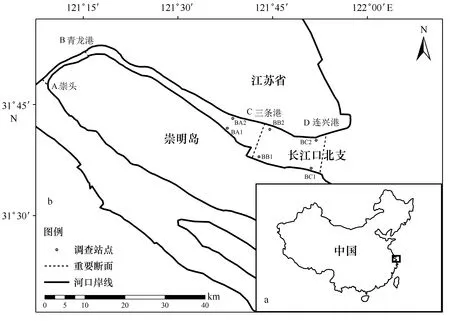
图1 长江口北支采样站点及重要断面图Fig.1 Sampling sites and important transects in the North Branch of Yangtze Estuary
2.2 研究方法
2.2.1 历史数据收集汇总
收集近30年来长江口北支河道相关的文献资料,对近30年来北支河道的圈围工程、平均河宽、河道水深、分流比、分沙比等数据信息进行汇总,归纳总结近30年长江口北支河道的演变特征,作为遥感影像分析结果的补充。
2.2.2 遥感信息提取与分析
选取1985、1990、1995、2001、2005、2009年中6幅云量较少的Landsat 5 TM遥感影像及2015年一期Landsat 8 TM遥感影像作为数据源。根据遥感影像中的岸线遥感解译标志,对各年份的遥感影像进行目视解译,并利用ArcMap10.2软件数字化,以10年为间隔提取绘制1985、1995、2005及2015年的北支岸线,对比分析近30年来长江口北支岸线的演变过程[39-40]。同时,沿北支自上而下垂直于河道中心线分别在崇头(A)、青龙港(B)、三条港(C)及北支口门连兴港(D)附近布设4条代表性断面,提取计算全部7个代表年份中河道重要断面宽度,以及由崇头断面(A)、口门断面(D)与两侧堤岸岸线所围成的北支水域面积等数据信息,并分析其30年来的变化特征。
2.2.3 生态现状调查
2013年5月对北支中下段水域生态现状进行了取样调查。调查共设置3个断面(BA,BB,BC),每断面设置2个站点,具体调查站点如图1所示。主要调查分析方法参照中华人民共和国国家标准《海洋调查规范第六部分:海洋生物调查(GB/T 12763.6-2007)》执行。采用阿氏网拖网采集底上的大型底栖动物及鱼类。每站点拖3网,每次拖网15 min。所有样品在现场固定以后,带回实验室进行鉴定、计数(尾),测定生物量(湿质量,g)及鱼类体长。
2.2.4 数据处理
(1)优势度
采用相对多度、相对生物量及Pinkas相对重要性指数来表示不同种类的优势度特征[41-42]。其中,每个站点的生物个体数和生物量均利用3网调查数据的平均值进行表示。
相对多度N(%)= 某种生物个体数/全部生物个体数×100% .
(1)
相对生物量B(%)= 某种生物生物量/全部生物生物量×100% .
(2)
相对频度F(%)= 某种生物出现的次数/总调研次数×100% .
(3)
Pinkas相对重要性指数(IRI) = (某种生物相对多度+某种生物相对生物量)×某种生物相对频度.
(4)
(2)多样性水平
采用Margalef物种丰富度指数、Shannon-Wiener多样性指数、Pielou均匀度指数对相应生物类群的多样性特征进行测度[42]。
Margalef物种丰富度指数:
(5)
Shannon-Wiener多样性指数:
H′=-∑PilnPi,
(6)
Pielou均匀度指数:
(7)
式中,S为总物种数;N为总个体数;Pi为第i种个体数占总个体数的比例。
3 研究结果
3.1 近30年北支演变
近30年北支岸线变迁特征如图2所示。近30年来,北支的束窄主要集中在三条港以上的河段。重要断面宽度变化特征如图3所示。2015年北支口门处河宽约10.0 km,与1985年的11.9 km相比束窄了16.0%;2015年崇头断面宽度仅为2.3 km,与1985年相比束窄了49.2%;上段青龙港断面由1985年的2.6 km下降至2015年的1.0 km;中段三条港断面由1985年的8.8 km束窄至2015年的6.3 km,宽度下降28.4%。此外,北支水域面积明显缩减(图4),1985年北支水域面积426.2 km2,2015年该面积缩减为285.9 km2,仅占1985年水域面积的67.1%,年均缩减率为1.1%。
从表1中不难看出,20世纪80年代以来,长江口北支先后进行了江滨沙圈围、永隆沙圈围、灵甸沙圈围等7个主要区域的圈围工程,圈围总面积达到110.7 km2。大规模的围堤工程,致使北支水道束窄明显。其中,90年代实施的圩角沙群圈围束窄了崇头断面;1978年开始建设的兴隆沙圈围以及90年代实施的新跃沙、灵甸沙、崇明北湖等北支中段及上段的圈围工程极大程度地束窄了北支中上段的河道。近30年来,北支水道不断萎缩,其河道平均河宽呈现明显的下降趋势;上段青龙港断面河道水深在20世纪末增加,而在2003年发生明显减小,2005年之后又有一定程度的增加,但与20世纪80年代相比,断面水深明显下降;中下段三条港断面水深自1985至2005年明显下降,2009年水深虽然有所增加,但较20世纪80年代水深仍然是下降的。0 m以下河槽容积近30年来持续下降,1984—2009年间整体下降65.3%。此外,北支河道的分流比自1980年至1991年呈现上升趋势,而自20世纪末以来下降明显。而北支河道的分沙比20世纪80年代呈现下降趋势;自2004年以来,除2004年大潮期以外,整体相比20世纪80年代有所上升且总体上大潮期分沙比均小于小潮期。

图2 近30年来长江口北支河道岸线的变迁Fig.2 Variation of the shoreline of the North Branch of Yangtze Estuary in last 30 years
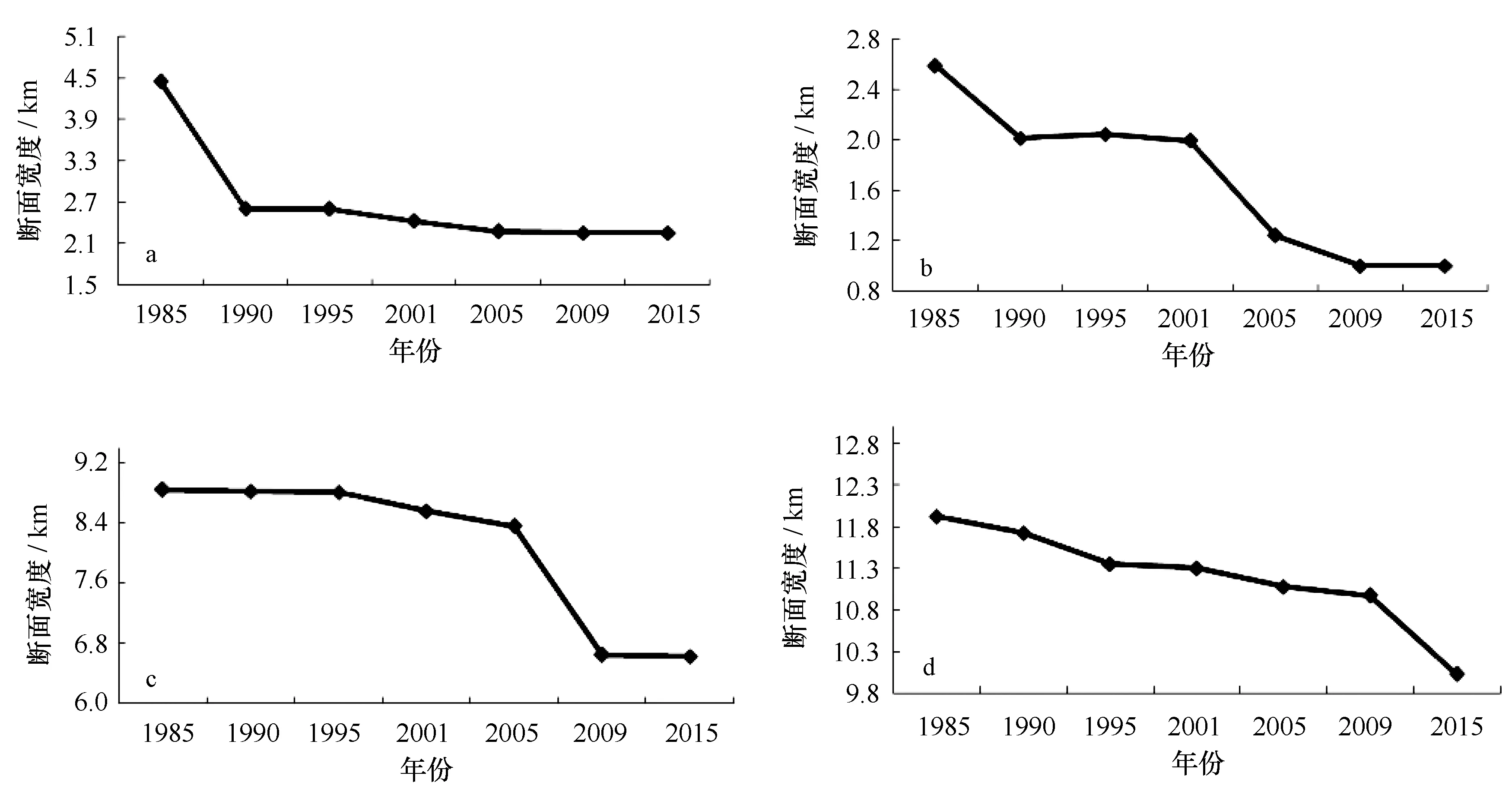
图3 1985—2015年长江口北支重要断面的宽度变化Fig.3 Variation of the widths of the important transects of the North Branch of Yangtze Estuary in 1985—2015a.崇头断面, b.青龙港断面, c.三条港断面, d.口门断面a.Chongtou transect, b.Qinglonggang transect, c.Santiaogang transect, d.Exit transect

图4 1985—2015年长江口北支水域面积的变化Fig.4 Variation of the water area of the North Branch of Yangtze Estuary in 1985—2015

时段圈围工程平均河宽/m河道水深/m 青龙港 三条港 0m以下河槽容积/106m3北支分流比/%分沙比/%数据来源1980-1985江滨沙圈围3.7km2(1972-1985)[36]永隆沙圈围20.4km2(1968-1982)[36]4438.0(1984)[45]3.9(1984)[39]4.7(1984)[39]1746.1(1984)[46]0.6(198408)[47]-8.2(198408)[51]张志林等[36]1985-1990—4278.0(1989)[39]———3.7(1987)[49]2.9(198803S)[50]-24.2(198803)[51]刘曦等[39]张静怡等[43]1990-1995兴隆沙圈围13.9km2(1978-1992)[43]3404.0(1991)[45]4.2(1991)[45]4.4(1991)[39]1552.0(1991)[46]4.4(1991)[51]—陈泾和朱建荣[44]李伯昌[45]1995-2000灵甸沙圈围8.1km2(1997-2000)[43]新跃沙圈围4.9km2(1998)[36]3192.0(1998)[45]5.0(1998)[45]4.2(1998)[36]1433.4(1998)[46]——恽才兴[46]闵凤阳等[47]2000-2005圩角沙群圈围19.5km2(1992-2002)[36]崇明北湖圈围32.9km2(2003)[36]2636.0(2003)[45]1.9(2003)[39]3.3(2005)[36]760.6(2005)[46]2.0(200209S)[48]2.0(200209E)[48]-66.0(200408S)[51]7.3(200408E)[51]胡静[48]陈维[49]2005-2010新村沙圈围7.3km2(2012)[44]2625.0(2005)[45]2.5(2009)[39]3.7(2009)[45]605.5(2009)[46]1.9(200709S)[47]1.8(200709E)[47]0.6(200707S)[51]3.9(200707E)[51]陈宝冲[50]李伯昌等[51]
注:表中月份后S为大潮期,E为小潮期,-表示无相应记录。
3.2 北支水域生态现状
3.2.1 大型底栖无脊椎动物
调查期间共采集大型底栖无脊椎动物标本1 346头,分属3门4纲11目23科34种,如表2所示。各断面优势种组成有一定差异。上侧断面(BA)以黑龙江河篮蛤(Potamocorbulaamurensis)占优势(IRI>20),其无论相对多度(80.00%)还是相对生物量(93.72%)均最大;中间断面(BB)以安氏白虾(Exopalaemonannandalei)和细指长臂虾(Palaemontenuidactylus)为主要优势种(IRI>20),两者相对多度(29.35%,26.13%)明显高于其他物种,而该断面生物量以细指长臂虾(21.92%)和短文蛤(Meretrixpetechialis)(18.67%)为主;下侧断面(BC)以安氏白虾为优势种(IRI>20),安氏白虾(24.84%)和糠虾(Acanthomysissp.)(20.50%)在数量上居多,但由于糠虾个体较小,断面生物量主要以安氏白虾(65.68%)为主。从断面的多样性特征来看,如图5所示,口内从上至下,几种多样性指数均是增加的。

表2 长江口北支各断面大型底栖无脊椎动物组成特征
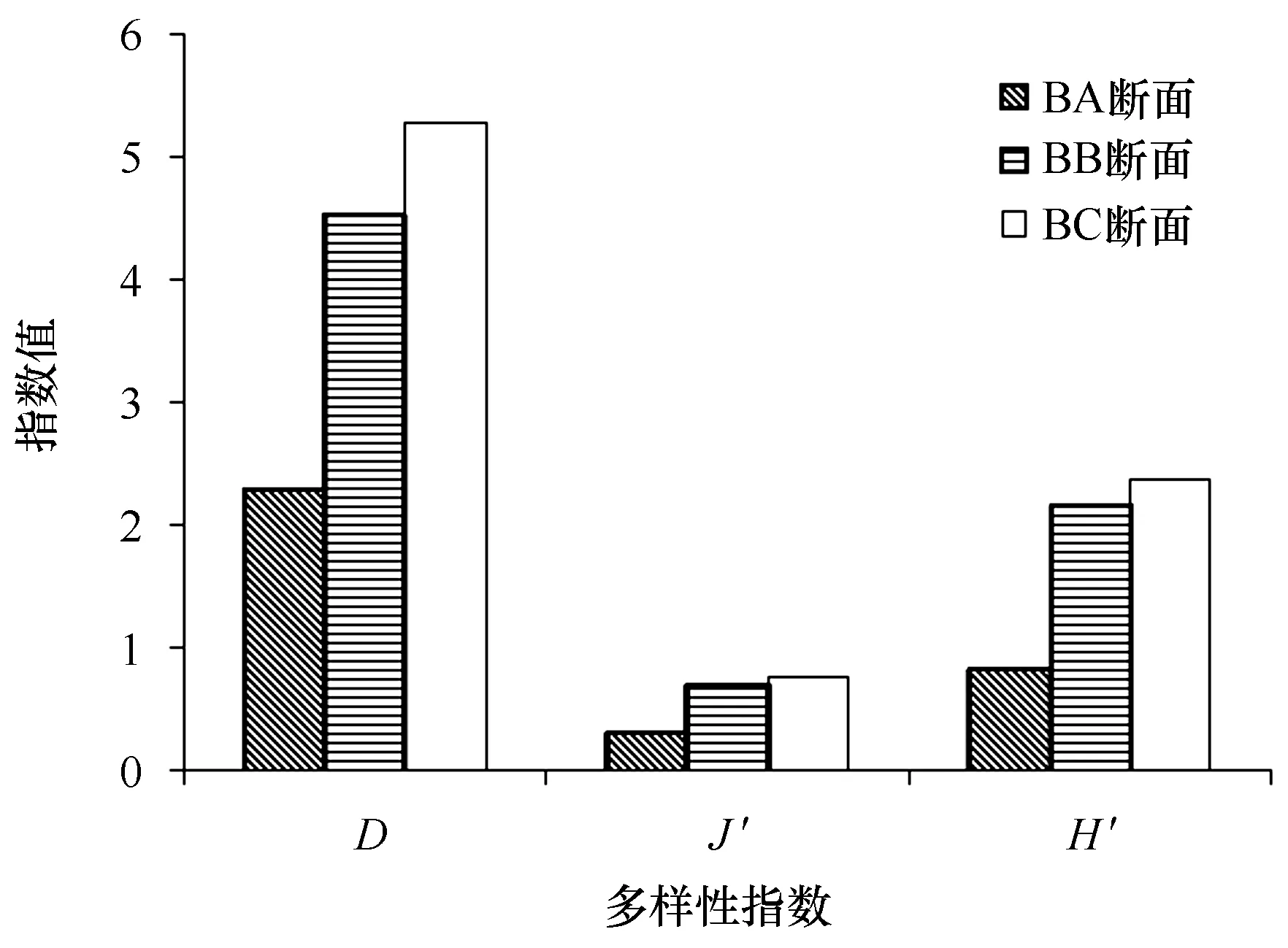
图5 长江口北支各断面大型底栖无脊椎动物物种多样性Fig.5 Species diversity of the benthic macroinvertebrate assemblages in the different transects of the North Branch of Yangtze Estuary
3.2.2 鱼类
调查期间共采集鱼类标本243尾,分属5目5科10种。其中,海洋鱼类2种,洄游鱼类2种,定居性河口鱼类5种,淡水鱼类1种。各断面鱼类种类组成及数量特征如表3所示。棘头梅童鱼(Collichthyslucidus)在3个断面上均占优势(IRI>20)。上侧断面(BA)除棘头梅童鱼外,红狼牙虾虎鱼(Odontamblyopusrubicundus)也为优势种(IRI>20),棘头梅童鱼在数量上居多(71.71%),而生物量以红狼牙虾虎鱼为主(47.10%);中间断面棘头梅童鱼数量高于其他物种(79.17%),生物量以红狼牙虾虎鱼(27.59%)、短吻红舌鳎(Cynoglossusjoyneri)(24.54%)、棘头梅童鱼(23.44%)为主;下侧断面鱼类生物量基本以棘头梅童鱼为主(78.61%),而棘头梅童鱼的数量也远高于其他种类(97.44%)。

表3 长江口北支各断面鱼类组成特征
注:1)海洋鱼类 Marine fish;2)洄游鱼类 Migratory fish;3)定居性河口鱼类 Resident estuarine fish;4)淡水鱼类 Freshwater fish。
各断面鱼类物种多样性如图6所示。相对而言中间断面(BB)物种多样性水平相对较高,其Margalef物种多样性指数及Shannon-Wiener多样性指数均高于其他断面。但是由于各断面基本上都是棘头梅童鱼在数量上占绝对优势,其均匀度水平都较低。
此外,从调查到的鱼类体长特征来看,如表4所示,调查期间北支水域鱼类主要以幼鱼为主。
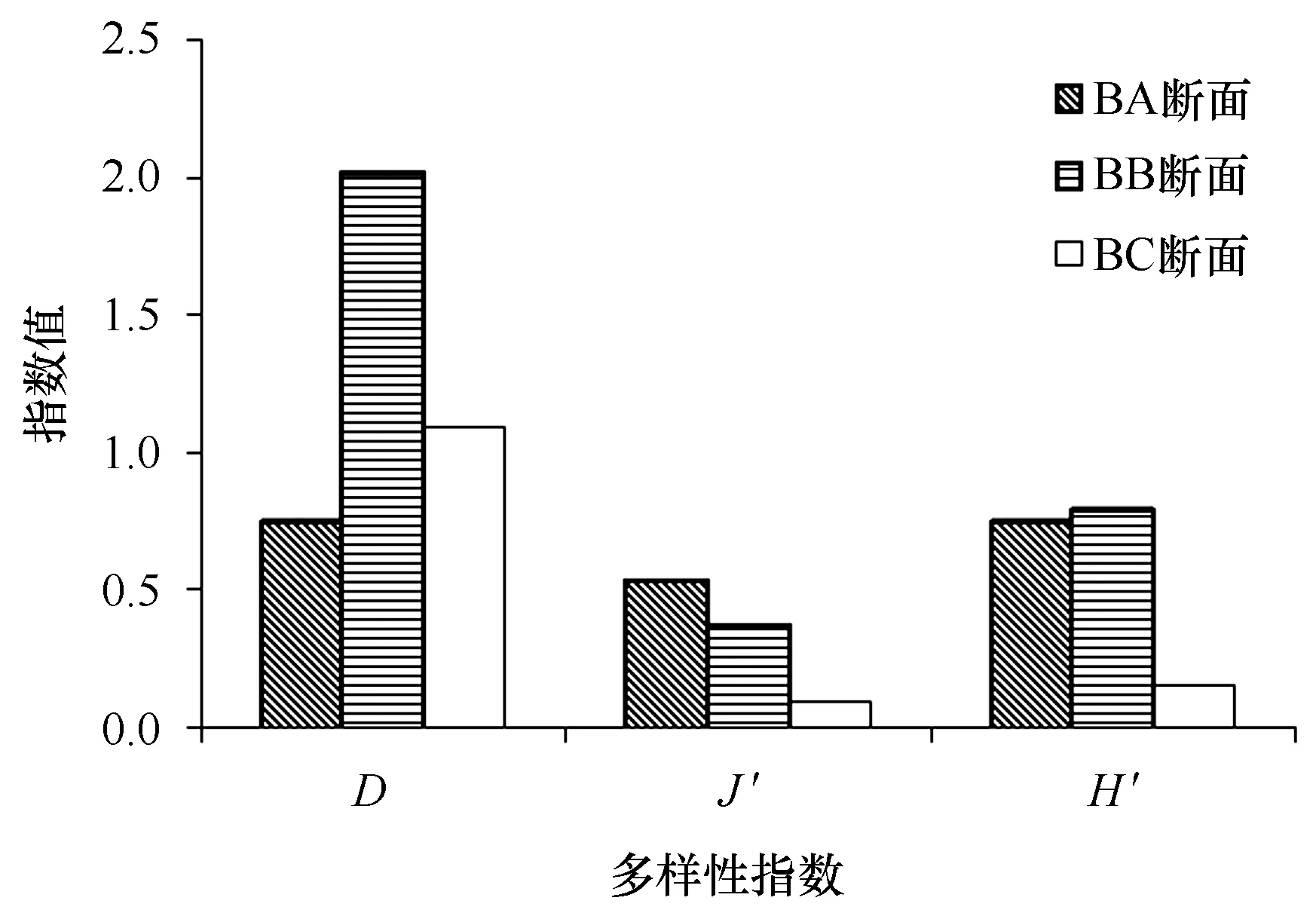
图6 长江口北支各断面鱼类物种多样性Fig.6 Species diversity of the fish assemblages in the different transects of the North Branch of Yangtze Estuary
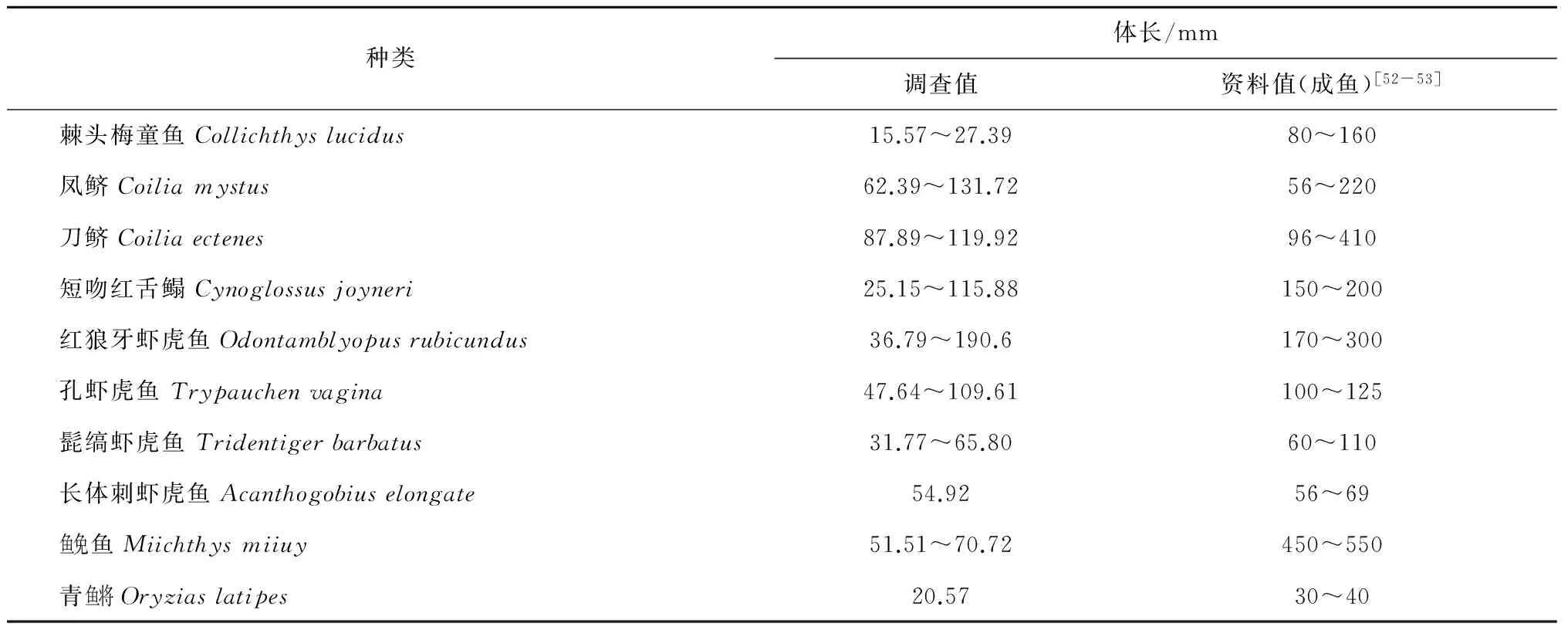
种类体长/mm调查值资料值(成鱼)[52-53]棘头梅童鱼Collichthyslucidus15.57~27.3980~160凤鲚Coiliamystus62.39~131.7256~220刀鲚Coiliaectenes87.89~119.9296~410短吻红舌鳎Cynoglossusjoyneri25.15~115.88150~200红狼牙虾虎鱼Odontamblyopusrubicundus36.79~190.6170~300孔虾虎鱼Trypauchenvagina47.64~109.61100~125髭缟虾虎鱼Tridentigerbarbatus31.77~65.8060~110长体刺虾虎鱼Acanthogobiuselongate54.9256~69鱼免鱼Miichthysmiiuy51.51~70.72450~550青鱼将Oryziaslatipes20.5730~40
4 讨论
4.1 北支演变与盐水入侵
根据本文研究结果,近30年来北支演变的突出特点在于北支中上段束窄明显,而下段河道虽然有一定程度的束窄,但口门仍呈喇叭口形态。大量的圈围工程是导致北支中上段河道束窄的最重要因素。北支中上段的束窄,造成北支径流分流比下降,使得径流作用减弱,从而削弱了径流对河床的冲刷作用;另一方面,虽然近年来长江口入海泥沙量显著下降,但是北支分沙比有所增大,整体上向北支的净泥沙输送量增加[51],两方面结合,加快了北支的淤浅,集中体现在河道水深以及0 m以下河槽容积的下降。河槽容积及河道地形的改变,对北支水域的水文过程产生深刻影响,使径流和潮流作用对比发生明显改变。在北支中上段高、低潮位整体抬升,涨潮流速增大,常形成涌潮[11],由此也增加了水、沙、盐倒灌南支的风险。
河口区作为咸淡水交汇的区域,盐水在径流与潮流的相互作用下在分汊河口内移动,潮流作用相对强烈的河道内,盐水沿河道上溯。近30年来北支水动力条件的改变,尤其是径流作用的相对减弱和潮流作用的相对增强,加剧了北支盐水入侵[37]。盐水入侵影响了北支水域尤其是北支中上段的水质状况。已有的研究表明北支中段三条港长期处于高盐度状态,而枯季大潮期径流作用较弱、潮流优势作用明显,更加剧烈的盐水入侵使得上段青龙港盐度也显著上升[54]。除此之外,盐水入侵严重时段,盐水可以从北支倒灌进入南支,对青草沙水库、陈行水库、东风西沙水库取水口的水质造成影响[55]。
4.2 北支演变对物种多样性的影响
盐度是影响河口区鱼类、大型底栖动物以及浮游动物等生物类群物种多样性及其分布的重要因素[56-59]。从水域生态现状调研结果来看,北支仍然是大型底栖动物、鱼类等生物类群的重要栖息地和育幼场,具有较高的生物多样性。与北支河道演变相伴随的盐水入侵势必会对区域生物类群的物种组成、分布以及多样性造成一定程度的影响。20世纪80年代末期,北支水域浮游甲壳动物以适应高盐度的桡足类占优势,而淡水枝角类尚存21种[60];到了2010年调查时,仅记录到枝角类5种[61]。此外,北支水域中浮游动物、浮游植物及大型底栖动物的物种组成及多样性受到丰枯季及离口门距离差异引起的盐度差异的影响[27,32,62]。从长江口南北支已有研究结果看,盐度差异是导致南北支水生生物种类组成差异的重要原因。如2005年长江口鱼类调查表明,北支水域鱼类以海洋鱼类、河口鱼类为主,主要优势种为棘头梅童鱼、红狼牙虾虎鱼,而南支水域鱼类则以淡水种为主[29]。同年,大型底栖动物调查结果表明,南支大型底栖动物以淡水和半咸水种为主,而北支则以混合高盐水种为主[63]。此外,长江口浮游动物已有的研究均表明盐度是导致南北支水域浮游动物群落结构差异的决定性因素[27-28]。在世界其他河口的相关研究中也获得了类似的研究结果。如1993年Marques等研究发现人工促淤改变了蒙德古河口南支的水动力条件,减少了淡水流入量,使得南支水域盐度明显高于北支,造成两条汊道的底栖动物群落结构出现明显差异[64];1999年Colonnello等人发现在委内瑞拉奥里诺科河口建坝后,坝址下游区域由于径流量下降,导致盐水入侵加剧,区域植被格局发生了彻底的改变,水域生物类群的组成与分布也发生了明显的变化[65]。此外,在河口浮游动物、鱼类的相关研究中也有较多类似的报道[66-67]。
除了盐度以外,北支演变引起的河道水深、水沙特征及水动力条件的改变也可能对区域生态系统造成直接或间接的影响。近30年来,北支河道总体呈淤浅态势。水深条件的改变,可能会使相应区域生物类群的组成发生明显变化。一些学者曾对印度维拉尔河口以及欧洲西部斯海尔德河口大型底栖无脊椎动物的群落组成及分布进行研究,结果发现区域内大型底栖动物群落组成和分布受到水深的影响,不同类别的底栖动物适宜生存的水深有所不同[68-69]。此外,众多研究表明,鱼类、浮游动物群落同样受到水深条件的影响,河道的淤浅可能导致适应深水环境的物种的多度下降[70-71]。此外,随着北支演变而产生的北支中上段涨、落潮流速的增大[35],水体悬沙浓度减小[72]均可能对相应的生物类群及其栖息环境产生影响。具体而言,不同水生生物所能耐受的水体最大流速存在差异,而高流速的水体往往不适宜许多物种的生存[68,73];而对于部分水生生物,悬沙浓度也是影响其种群密度的重要因素[74-75],北支悬沙浓度的减小可能导致适应高悬沙浓度的物种被替代。但是,所有的因子的作用并不是孤立进行的,而是相互联系、相互制约的。不同因子的相互作用及其生态效应,还有待于未来系统监测基础上的综合分析。
综上所述,近30年来,由于围垦等人类活动的影响,北支河段河势发生了明显的改变,由此引发的生境条件的改变,尤其是盐度的变化,对区域大型底栖动物、鱼类等生物类群的物种组成、多样性及空间分布等产生了一定程度的影响。北支水域主要生物类群以适应高盐、咸淡水环境的种类为主。但北支水域仍然是鱼类等水生生物的重要栖息地和育幼场,且具有较高的生物多样性。北支的治理,仍需要考虑维持区域生态系统的结构与功能不被破坏,确保区域的可持续发展。其重要的途径是保证现有的水域面积(包括近岸湿地)不会进一步丧失,同时减少北支口门的进潮量,降低盐水倒灌南支的风险。而为了减少北支口门的进潮量,可以考虑以生态工程代替钢筋混凝土的硬工程:以覆盖植被的拦门沙脊降低口门区河道宽度和容积。具体拦门沙脊的布设方式需要根据区域地形、水动力条件等研究确定。未来北支的演变趋势及其生态效应,需要在有效监测的基础上进行综合分析。
[1] 孙志林, 金元欢. 分汊河口的形成机理[J]. 水科学进展, 1996, 7(2): 144-150.
Sun Zhilin, Jin Yuanhuan. Mechanism of formation of an anabranchedestuary[J]. Advances in Water Science, 1996, 7(2): 144-150.
[2] 陈吉余. 21世纪的长江河口初探[M]. 北京: 海洋出版社, 2009.
Chen Jiyu. A Preliminary Study of the Yangtze Estuary in the 21st Century[M]. Beijing: China Ocean Press, 2009.
[3] 陈吉余, 恽才兴, 徐海根, 等. 两千年来长江河口发育的模式[J]. 海洋学报, 1979, 1(1): 103-111.
Chen Jiyu, Yun Caixing, Xu Haigen, et al. The development model of the Changjiang River Estuary during last 2000 years[J]. Haiyang Xuebao, 1979, 1(1): 103-111.
[4] Van Der Wal D, Pye K, Neal A. Long-term morphological change in the Ribble Estuary, northwest England[J]. Marine Geology, 2002, 189(3/4): 249-266.
[5] Blott S J, Pye K, Van Der Wal D, et al. Long-term morphological change and its causes in the Mersey Estuary, NW England[J]. Geomorphology, 2006, 81(1/2): 185-206.
[6] Allison M A, Vosburg B M, Ramirez M T, et al. Mississippi River channel response to the Bonnet Carré Spillway opening in the 2011 flood and its implications for the design and operation of river diversions[J]. Journal of Hydrology, 2013, 477: 104-118.
[7] 陈吉余, 陈沈良. 长江口生态环境变化及对河口治理的意见[J]. 水利水电技术, 2003, 34(1): 19-25.
Chen Jiyu, Chen Shenliang. The changes of ecologic environment in Yangtze River estuary and some suggestions for estuary regulation[J]. Water Resources and Hydropower Engineering, 2003, 34(1): 19-25.
[8] Lane R R, Day J W Jr, Marx B D, et al. The effects of riverine discharge on temperature, salinity, suspended sediment and chlorophyll in a Mississippi delta estuary measured using a flow-through system[J]. Estuarine, Coastal and Shelf Science, 2007, 74(1/2): 145-154.
[9] De Vriend H J, Wang Zhengbing, Ysebaert T, et al. Eco-Morphological problems in the Yangtze Estuary and the Western Scheldt[J]. Wetlands, 2011, 31(6): 1033-1042.
[10] Ferguson G J, Ward T M, Ye Qifeng, et al. Impacts of drought, flow regime, and fishing on the fish assemblage in Southern Australia’s largest temperate estuary[J]. Estuaries and Coasts, 2013, 36(4): 737-753.
[11] 宋泽坤. 近30年来长江口北支滩涂围垦对水动力和河槽冲淤演变影响分析[D]. 上海: 华东师范大学, 2013.
Song Zekun. Analysis of reclamation in the North Branch and its effects on hydrodynamic environment and morphological change for nearly 30 years[D]. Shanghai: East China Normal University, 2013.
[12] Wu Hui, Zhu Jiianrong, Chen Bingrui, et al. Quantitative relationship of runoff and tide to saltwater spilling over from the North Branch in the Changjiang Estuary: A numerical study[J]. Estuarine, Coastal and Shelf Science, 2006, 69(1/2): 125-132.
[13] Yu Shipeng, Yang Jingsong, Liu Guangming. Impact assessment of Three Gorges Dam's impoundment on river dynamics in the North Branch of Yangtze River Estuary, China[J]. Environmental Earth Sciences, 2014, 72(2): 499-509.
[14] 陆婷婷. 长江口北支河道演变及其影响分析[J]. 中国水运, 2014, 14(7): 204-205.
Lu Tingting. Evolution of North Branch of Yangtze River Estuary and its impact analysis[J]. China Water Transport, 2014, 14(7): 204-205.
[15] 杨芳丽, 韩婷, 闫军, 等. 长江口北支河段演变分析及航道治理思路初探[J]. 水运工程, 2014 (12): 79-82.
Yang Fangli, Han Ting, Yan Jun, et al. River regime and regulation of Beizhi reach in lower reach of the Yangtze River[J]. Port & Waterway Engineering, 2014(12): 79-82.
[16] 陈炜, 李九发, 李占海, 等. 长江口北支强潮河道悬沙运动及输移机制[J]. 海洋学报, 2012, 34(2): 84-91.
Chen Wei, Li Jiufa, Li Zhanhai, et al. The suspended sediment transportation and its mechanism in strong tidal reaches of the North Branch of the Changjiang Estuary[J]. Haiyang Xuebao, 2012, 34(2): 84-91.
[17] Dai Zhijun, Du Jinzhou, Chu Ao, et al. Sediment characteristics in the North Branch of the Yangtze Estuary based on radioisotope tracers[J]. Environmental Earth Sciences, 2011, 62(8): 1629-1634.
[18] Li Xie, Zhang Zhenke, Zhang Yunfeng, et al. Sedimentation and morphological changes at Yuantuojiao Point, estuary of the North Branch, Changjiang River[J]. Acta Oceanologica Sinica, 2013, 32(2): 24-34.
[19] Li Zhanhai, Li M Z, Dai Zhijun, et al. Intratidal and neap-spring variations of suspended sediment concentrations and sediment transport processes in the North Branch of the Changjiang Estuary[J]. Acta Oceanologica Sinica, 2015, 34(1): 137-147.
[20] 周开胜, 孟翊, 刘苍字, 等. 长江口北支沉积特征及北支河道演变[J]. 泥沙研究, 2009(6): 65-73.
Zhou Kaisheng, Meng Yi, Liu Cangzi, et al. Sedimentation characteristic and channel evolvement in the North Branch of the Yangtze River Estuary[J]. Journal of Sediment Research, 2009(6): 65-73.
[21] Lin Xiaobiao, Hou Lijun, Liu Min, et al. Gross nitrogen mineralization in surface sediments of the Yangtze Estuary[J]. PLoS One, 2016, 11(3): e0151930.
[22] 朱建荣, 吴辉, 顾玉亮. 长江河口北支倒灌盐通量数值分析[J]. 海洋学研究, 2011, 29(3): 1-7.
Zhu Jianrong, Wu Hui, GuYuliang. Numerical analysis of the inverted salt flux from the North Branch into the South Branch of Changjiang River Estuary[J]. Journal of Marine Sciences, 2011, 29(3): 1-7.
[23] Zhang Erfeng, Savenije H H G, Wu Hui, et al. Analytical solution for salt intrusion in the Yangtze Estuary, China[J]. Estuarine, Coastal and Shelf Science, 2011, 91(4): 492-501.
[24] Li Lu, Zhu Jianrong, Wu Hui. Impacts of wind stress on saltwater intrusion in the Yangtze Estuary[J]. Science China Earth Sciences, 2012, 55(7): 1178-1192.
[25] Qiu Cheng, Zhu Jianrong. Influence of seasonal runoff regulation by the Three Gorges Reservoir on saltwater intrusion in the Changjiang River Estuary[J]. Continental Shelf Research, 2013, 71: 16-26.
[26] 吴华林, 张俊勇, 刘高峰. 长江口北支综合整治与开发思路探讨[J]. 长江流域资源与环境, 2011, 20(S1): 9-13.
Wu Hualin, Zhang Junyong, Liu Gaofeng. Discussion of comprehensive control and development of the North Branch of the Changjiang Estuary[J]. Resources and Environment in the Yangtze Basin, 2011, 20(S1): 9-13.
[27] 郑金秀, 胡菊香, 彭建华, 等. 长江口南北支浮游动物群落生态学研究[J]. 生态环境学报, 2011, 20(6): 1102-1106.
Zheng Jinxiu, Hu Juxiang, Peng jianhua, et al. Zooplankton community ecology in north and south branches at Yangtze River Estuary[J]. Ecology and Environment, 2011, 20(6): 1102-1106.
[28] 高倩, 徐兆礼, 庄平. 长江口北港和北支浮游动物群落比较[J]. 应用生态学报, 2008, 19(9): 2049-2055.
Gao Qian, Xu Zhaoli, Zhuang Ping. Comparison of mesozooplankton communities in North Channel and North Branch of Yangtze River Estuary[J]. Chinese Journal of Applied Ecology, 2008, 19(9): 2049-2055.
[29] 张衡, 朱国平, 陆健健. 长江河口湿地鱼类的种类组成及多样性分析[J]. 生物多样性, 2009, 17(1): 76-81.
Zhang Heng, Zhu Guoping, Lu Jianjian. Fish species composition and diversity of Yangtze River estuarine wetland[J]. Biodiversity Science, 2009, 17(1): 76-81.
[30] 杨刚, 张涛, 庄平, 等. 长江口棘头梅童鱼幼鱼栖息地的初步评估[J]. 应用生态学报, 2014, 25(8): 2418-2424.
Yang Gang, Zhang Tao, Zhuang Ping, et al. Preliminary assessment of habitat of juvenileCollichthyslucidusin the Yangtze Estuary[J]. Chinese Journal of Applied Ecology, 2014, 25(8): 2418-2424.
[31] 孙永涛, 张金池. 长江口北支湿地鸟类多样性研究——鸟类物种多样性研究[J]. 湿地科学与管理, 2010, 6(3): 50-53.
Sun Yongtao, Zhang Jinchi. Bird diversity in the estuary wetland of North Branch of Yangtze River—species diversity of birds[J]. Wetland Science & Management, 2010, 6(3): 50-53.
[32] 罗民波, 沈新强, 徐兆礼, 等. 长江口北支水域潮间带大型底栖动物研究[J]. 海洋环境科学, 2006, 25(4): 43-47.
Luo Minbo, Shen Xinqiang, Xu Zhaoli, et al. Study on intertidal macrobenthos in North Branch of Changjiang Estuary[J]. Marine Environmental Science, 2006, 25(4): 43-47.
[33] 赵开彬, 刘婧, 吴惠仙, 等. 长江口北支大型底栖动物群落周年变化特征[J]. 生物学杂志, 2014, 31(3): 1-6.
Zhao Kaibin, Liu Jing, Wu Huixian, et al. Anniversary variation characteristics of benthic animal community in the North Branch of the Yangtze River estuary[J]. Journal of Biology, 2014, 31(3): 1-6.
[34] 张风艳. 长江口北支表层沉积物特征分析及其环境与物源意义[D]. 上海: 华东师范大学, 2011.
Zhang Fengyan. Study on the characteristics of surface sediment in north branch of Changjiang Estuary and analysis of its sedimentary environment and sediment source[D]. Shanghai: East China Normal University, 2011.
[35] 宋泽坤, 程和琴, 胡浩, 等. 长江口北支围垦对其水动力影响的数值模拟分析[J]. 人民长江, 2012, 43(15): 59-63.
Song Zekun, Cheng Heqin, Hu Hao, et al. Numerical simulation analysis of influence of reclamation of North Branch in the Yangtze River Estuary on hydrodynamic characteristics[J]. Yangtze River, 2012, 43(15): 59-63.
[36] 张志林, 阮伟, 刘桂平, 等. 长江口北支近期河势演变与航道资源开发研究[J]. 海洋工程, 2009, 27(3): 96-103.
Zhang Zhilin, Ruan Wei, Liu Guiping, et al. Recent river regime evolution of the North Branch of the Yangtze River Estuary and development research of navigational channel resources[J]. The Ocean Engineering, 2009, 27(3): 96-103.
[37] 张二凤, 陈沈良, 刘小喜. 长江口北支异常强盐水入侵观测与分析[J]. 海洋通报, 2014(5): 491-496.
Zhang Erfeng, Chen Shenliang, Liu Xiaoxi. Observation and analysis of abnormal strong saltwater intrusion in the North Branch of the Yangtze Estuary[J]. Marine Science Bulletin, 2014(5): 491-496.
[38] 赵捷, 何青, 王宪业, 等. 长江口南北支水沙特性观测研究[J]. 长江流域资源与环境, 2015, 24(1): 21-29.
Zhao Jie, He Qing, Wang Xianye, et al. Field observations on the characteristics of current and sediment of the South and North Branches in the Yangtze Estuary[J]. Resources and Environment in the Yangtze Basin, 2015, 24(1): 21-29.
[39] 刘曦, 杨丽君, 徐俊杰, 等. 长江口北支水道萎缩淤浅分析[J]. 上海地质, 2010, 31(3): 35-40.
Liu Xi, Yang Lijun, Xu Junjie, et al. The evolution of the north branch of Yangtze River Estuary characterized by being narrower and shallower[J]. Shanghai Geology, 2010, 31(3): 35-40.
[40] 李晓敏, 张杰, 马毅. 1974年以来长江口北支沙洲演变过程遥感监测[J]. 人民长江, 2014, 45(21): 45-48, 53.
Li Xiaomin, Zhang Jie, Ma Yi. Remote sensing monitoring of sandbars evolution in north branch of Yangtze River estuary since 1974[J]. Yangtze River, 2014, 45(21): 45-48, 53.
[41] Laffaille P, Feunteun E, Lefeuvre J C. Composition of fish communities in a European macrotidal salt marsh (the Mont Saint-Michel Bay, France)[J]. Estuarine, Coastal and Shelf Science, 2000, 51(4): 429-438.
[42] 童春富. 长江河口潮间带盐沼植被分布区及邻近光滩鱼类组成特征[J]. 生态学报, 2012, 32(20): 6501-6510.
Tong Chunfu. Characteristics of the fish assemblages in the intertidal salt marsh zone and adjacent mudflat in the Yangtze Estuary[J]. Acta Ecologica Sinica, 2012, 32(20): 6501-6510.
[43] 张静怡, 黄志良, 胡震云. 围涂对长江口北支河势影响分析[J]. 海洋工程, 2007, 25(2): 72-77.
Zhang Jingyi, Huang Zhiliang, Hu Zhenyun. Effect of the reclamation project on the North Branch of Yangtze River Estuary[J]. The Ocean Engineering, 2007, 25(2): 72-77.
[44] 陈泾, 朱建荣. 长江口北支新村沙围垦工程对盐水入侵的影响[J]. 华东师范大学学报(自然科学版), 2014(4): 163-172.
Chen Jing, Zhu Jianrong. Impact of the reclamation project of Xincunsha on the saltwater intrusion in the North Branch of the Changjiang Estuary[J]. Journal of East China Normal University (Natural Science), 2014(4): 163-172.
[45] 李伯昌. 1984年以来长江口北支演变分析[J]. 水利水运工程学报, 2006(3): 9-17.
Li Bochang. Channel evolution in North Branch of Changjiang River Estuary since 1984[J]. Hydro-Science and Engineering, 2006(3): 9-17.
[46] 恽才兴. 图说长江河口演变[M]. 北京: 海洋出版社, 2010.
Yun Caixing. Caption of the Yangtze River Estuary Evolution[M]. Beijing: China Ocean Press, 2010.
[47] 闵凤阳, 汪亚平, 高建华, 等. 长江口北支潮周期尺度水沙通量及分流分沙比[C]// 第十四届中国海洋(岸)工程学术讨论会论文集.北京:海洋出版社, 2009.
Min Fengyang, Wang Yaping, Gao Jianhua, et al. Water sediment flux, water and sediment spilt ratio of North Branch of Yangtze Estuary in a tidal cycle scale[C]//The 14th China Ocean (Coast) Engineering Workshop Proceedings. Beijing:China Ocean Press, 2009.
[48] 胡静. 长江河口水沙分流和输移的探讨[D]. 上海: 华东师范大学, 2007.
Hu Jing. Flow and sediment ratios and transport in the Yangtze River Estuary[D]. Shanghai: East China Normal University, 2007.
[49] 陈维. 长江口北支、北槽冲淤变化及河势演变分析[D]. 上海: 上海海洋大学, 2012.
Chen Wei. Analysis on morphological change and evolution of river regime in the North Passage and North Branch of the Changjiang River Estuary[D]. Shanghai: Shanghai Ocean University, 2012.
[50] 陈宝冲. 长江口北支河势的变化与水、沙、盐的输移[J]. 地理科学, 1993, 13(4): 346-352.
Chen Baochong. The change of the general form and the transport of the water,load and salt in the north-branch of the Changjiang River mouth[J]. Scientia Geographica Sinica, 1993, 13(4): 346-352.
[51] 李伯昌, 余文畴, 陈鹏, 等. 长江口北支近期水流泥沙输移及含盐度的变化特性[J]. 水资源保护, 2011, 27(4): 31-34.
Li Bochang, Yu Wenchou, Chen Peng, et al. Variation characteristics of sediment transport and salinity in north branch channel of Yangtze River Estuary in recent years[J]. Water Resources Protection, 2011, 27(4): 31-34.
[52] 中国水产科学研究院东海水产研究所, 上海市水产研究所. 上海鱼类志[M]. 上海: 上海科学技术出版社, 1990.
East China Sea Fisheries Research Institute, Chinese Academy of Fishery Sciences, Shanghai Fisheries Research Institute. Shanghai Fishes[M]. Shanghai: Shanghai Scientific & Technical Publishers, 1990.
[53] 庄平, 王幼槐, 李圣法, 等. 长江口鱼类[M]. 上海: 上海科学技术出版公司, 2006.
Zhuang Ping, Wang Youhuai, Li Shengfa, et al. Fishes of the Yangtze Estuary[M]. Shanghai: Shanghai Scientific & Technical Publishers, 2006.
[54] 顾玉亮, 吴守培, 乐勤. 北支盐水入侵对长江口水源地影响研究[J]. 人民长江, 2003, 34(4): 1-3.
GuYuliang, Wu Shoupei, Le Qin. Impact of intruded saline water via north branch of the Yangtze River on water source areas in the estuary area[J]. Yangtze River, 2003, 34(4): 1-3.
[55] 李路. 长江河口盐水入侵时空变化特征和机理[D]. 上海: 华东师范大学, 2011.
Li Lu. Spatial-temporal dynamic characteristics of saltwater intrusion in the Changjiang Estuary[D]. Shanghai: East China Normal University, 2011.
[56] Josefson A B, Hansen J L S. Species richness of benthic macrofauna in Danish estuaries and coastal areas[J]. Global Ecology and Biogeography, 2004, 13(3): 273-288.
[57] Loshin D. Chapter 1-Market and business drivers for big data analytics[M]// Loshin D. Big Data Analytics. Boston: Morgan Kaufmann, 2013: 1-9.
[58] Gain A K, Uddin M N, Sana P. Impact of river salinity on fish diversity in the south-west coastal region of Bangladesh[J]. International Journal of Ecology and Environmental Sciences, 2008, 34(1): 49-54.
[59] Dou Pou, Cui Baoshan, Xie Tian, et al. Macrobenthos diversity response to hydrological connectivity gradient[J]. Wetlands, 2014, 36(S1): 45-55.
[60] 曾强. 长江口南、北支水域的浮游甲壳动物调查[J]. 淡水渔业, 1993, 23(1): 33-35.
Zeng Qiang. A study of crustacean plankton in South and North Branches of Yangtze Estuary[J]. Freshwater Fishery, 1993, 23(1): 33-35.
[61] 杨吉强, 王琼, 刘艳, 等. 长江口浮游甲壳动物空间分布特征[J]. 生物学杂志, 2014, 31(3): 11-14.
Yang Jiqiang, Wang Qiong, Liu Yan, et al. The spatial distribution characteristics of crustacean plankton in the Yangtze River Estuary[J]. Journal of Biology, 2014, 31(3): 11-14.
[62] 刘笑, 薛俊增, 吴惠仙. 长江口北支浮游植物群落结构周年变化特征[J]. 生物学杂志, 2014, 31(3): 20-24.
Liu Xiao, Xue Junzeng, Wu Huixian. Annual variation of phytoplankton community in the North Branch of the Yangtze River Estuary[J]. Journal of Biology, 2014, 31(3): 20-24.
[63] 章飞军, 童春富, 张衡, 等. 长江口潮下带春季大型底栖动物的群落结构[J]. 动物学研究, 2007, 28(1): 47-52.
Zhang Feijun, Tong Chunfu, Zhang Heng, et al. Community structure of macrobenthic fauna in subtidal areas of the Yangtze River Estuary in spring[J]. Zoological Research, 2007, 28(1): 47-52.
[64] Marques J C, Maranhão J C, Pardal M A. Human impact assessment on the subtidal macrobenthic community structure in the Mondego Estuary (Western Portugal)[J]. Estuarine, Coastal and Shelf Science, 1993, 37(4): 403-419.
[65] Colonnello G, Medina E. Vegetation changes induced by dam construction in a tropical estuary: the case of the Manamo River, Orinoco Delta (Venezuela)[J]. Plant Ecology, 1999, 139(2): 145-154.
[66] Watanabe K, Kasai A, Antonio E S, et al. Influence of salt-wedge intrusion on ecological processes at lower trophic levels in the Yura Estuary, Japan[J]. Estuarine, Coastal and Shelf Science, 2014, 139: 67-77.
[67] Jutagate T, Sawusdee A, Thapanand-Chaidee T, et al. Effects of an anti-salt intrusion dam on tropical fish assemblages[J]. Marine and Freshwater Research, 2010, 61(3): 288-301.
[68] Chertoprud M V, Chertoprud E S, Saravanakumar A, et al. Macrobenthic communities of the Vellar Estuary in the Bay of Bengal in Tamil-Nadu in South India[J]. Oceanology, 2013, 53(2): 200-210.
[69] Ysebaert T, Herman P M J, Meire P, et al. Large-scale spatial patterns in estuaries: estuarine macrobenthic communities in the Schelde Estuary, NW Europe[J]. Estuarine, Coastal and Shelf Science, 2003, 57(1/2): 335-355.
[70] Mansor M I, Mohammad-Zafrizal M Z, Nur-Fadhilah M A, et al. Temporal and spatial variations in fish assemblage structures in relation to the physicochemical parameters of the Merbok Estuary, Kedah[J]. Journal of Natural Sciences Research, 2012, 7(2): 110-127.
[71] Schlacher T A, Th W. Small-scale distribution and variability of demersal zooplankton in a shallow, temperate estuary: Tidal and depth effects on species-specific heterogeneity[J]. Cahiers de Biologie Marine, 1995, 36(3): 211-227.
[72] 杨云平, 张明进, 邓金运, 等. 长江口悬沙浓度变化的同步性和差异性[J]. 地理学报, 2014, 69(4): 1615-1627.
Yang Yunping, Zhang Mingjin, Deng Jinyun, et al. The synchronicity and difference in the change of suspended sediment concentration in the Yangtze River Estuary[J]. Acta Geographica Sinica, 2014, 69(4): 1615-1627.
[73] Johnson J A, Arunachalam M. Relations of physical habitat to fish assemblages in streams of Western Ghats, India[J]. Applied Ecology and Environmental Research, 2010, 8(1): 1-10.
[74] Ellis J, Cummings V, Hewitt J, et al. Determining effects of suspended sediment on condition of a suspension feeding bivalve (Atrinazelandica): results of a survey, a laboratory experiment and a field transplant experiment[J]. Journal of Experimental Marine Biology and Ecology, 2002, 267(2): 147-174.
[75] Ooi A L, Chong V C. Larval fish assemblages in a tropical mangrove estuary and adjacent coastal waters: Offshore-inshore flux of marine and estuarine species[J]. Continental Shelf Research, 2011, 31(15): 1599-1610.
Evolution of the North Branch of Yangtze Estuary in last 30 years and corresponding effects on species diversity
Wu Fengrun1, Tong Chunfu1
(1.StateKeyLaboratoryofEstuarineandCoastalResearch,EastChinaNormalUniversity,Shanghai200062,China)
The evolution characteristics of the anabranched estuary and their ecological effects are important issues of current estuarine and coastal research. The North Branch is one of the first order bifurcations of Yangtze Estuary. Its evolution would have profound effects on regional ecological and environmental conditions. In this study, we expounded the evolution characteristics of the North Branch of Yangtze Estuary in last 30 years, based on the pre-existing results and also the remote sensing image analysis. Together with the recent ecological investigation in the water area, their corresponding effects on species diversity were discussed thoroughly. The results proved that the prominent feature of the evolution was that the middle and upper segments of the North Branch got narrowed significantly, while the lower segment was less narrowed and still had a funnel shape. A large number of reclamations taken place in the middle and upper areas were responsible for this. With the changes of river regime, the water depth, channel volume and the split ratio of water of the North Branch decreased, while the split ratio of sediment went up. These had contributed to the intensive saltwater intrusions into the North Branch, and also the increased risks of the sediment and saltwater spilling into the South Branch. The North Branch evolution altered the salinity conditions of the water, which led to the dominant biomes appeared to be those adapted to the high salinity and brackish water. Furthermore, the variations of the water depth, hydrodynamic and sediment concentration of the water could also have effects on the biomes. However, at present, the North Branch was still an important habitat and nursery area for many biomes, such as the benthic macroinvertebrates, the fishes and so on, and still had higher biodiversity. As a consequence, we need to sustain the ecosystem structure and functions of the area to ensure the sustainable development of the region. We also need a comprehensive analysis on the basis of effective monitoring in the future to reveal the evolution trends of the North Branch and their corresponding effects.
Yangtze Estuary; North Branch evolution; species diversity
10.3969/j.issn.0253-4193.2017.02.007
2016-06-20;
2016-10-09。
上海市科委自然科学基金(15ZR1411200);教育部留学回国人员科研启动基金。
吴逢润(1993—),男,山东省新泰市人,从事河口及湿地生态学研究。E-mail:52152601021@ecnu.cn
*通信作者:童春富(1977—),男,副研究员,浙江省兰溪市人,从事河口及湿地生态学研究。E-mail:cftong@sklec.ecnu.edu.cn
Q178.53
A
0253-4193(2017)02-0072-14
吴逢润,童春富. 近30年长江口北支演变及其对物种多样性的影响[J].海洋学报,2017,39(2):72—85,
Wu Fengrun, Tong Chunfu. Evolution of the North Branch of Yangtze Estuary in last 30 years and corresponding effects on species diversity[J]. Haiyang Xuebao,2017,39(2):72—85, doi:10.3969/j.issn.0253-4193.2017.02.007
